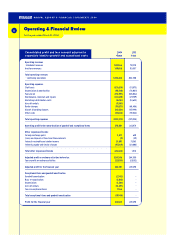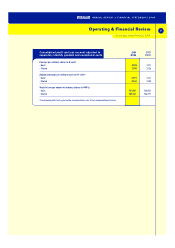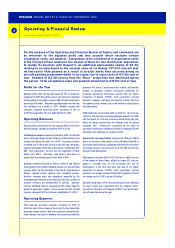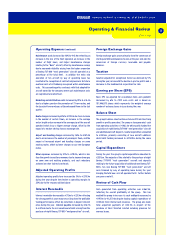Ryanair 2004 Annual Report Download - page 18
Download and view the complete annual report
Please find page 18 of the 2004 Ryanair annual report below. You can navigate through the pages in the report by either clicking on the pages listed below, or by using the keyword search tool below to find specific information within the annual report.
Corporate Governance (continued)
Accountability and Audit
The dire c to rs have set out their res p o n s i b i l i ty for the
p re p a ration of the financial sta te m e n t s on page 24. Th ey h ave
a l so co n s i d e red the going co n c ern p os i t i o n of the group and
their conclusion is set out on page 19. The Bo a rd has esta b l i s h e d
an Audit Co m m i t tee whose principal ta s ks are to co n s i d e r
financial re p o rting and internal co n t rol iss u es. The Au d i t
Co m m i tte e, which co n s i sts exc l u s i vely of independent non-
exe cu t i v e dire c to rs, meets at lea st quarterly to rev i ew the
financial sta te m e n ts of the gro u p, to consider internal co n t ro l
p ro ce d u r es and to liaise with internal and ex ternal audito rs. In
the year ended March 31, 2004 the Audit Co m m i ttee met on 5
o cca s i o n s. On a semi annual basis the Audit Co m m i ttee re ce i v es
an ex te n s i v e re p o rt from the internal auditor detailing the
rev i ews performed in the yea r, and a risk assessment of the
g ro u p. This re p o rt is used by the Co m m i ttee and the Bo a rd, as a
basis for determining the effe c t i ve n ess of internal co n t rol. Th e
Audit Co m m i ttee regularly co n s i d e rs the perfo r m a n ce of
i n ternal audit and how best financial re p o rting and inte r n a l
co n t rol principles should be applied.
Internal Control
The directors acknowledge their responsibility for the system
of internal control which is designed to manage rather than
eliminate the risk of failure to achieve business objectives, and
can provide only rea sonable and not abso l u te ass u ra n ce
against material mis-statement or loss.
In accordance with the provisions of the Combined Code the
directors review the effectiveness of the group’s system of
internal controlincluding:
•Financial
•Operational
•Compliance
•Risk
•Management
The Board is ultimately responsible for the group’s system of
internal controls and for monitoring its effectiveness. Formal
guidance for directors on the implementation of the new
re q u i re m e n ts entitled “Internal Co n t rol: Guidance fo r
Directors on the Combined Code”, was published in September,
1999 (“the Turnbull guidance”). The Board established the
procedures necessary to implement the Turnbull guidance
during 1999.
The key procedures that have been established to provide
effective internal control include:
•a strong and independent Board which meets at least 4
t i m es a year and has se p a ra te Chief Exe cu t i ve and
Chairman roles;
• a clearly defined organisational structure along functional
lines and a clear division of responsibility and authority in
the group;
•a ve ry co m p re h e n s i ve system of internal fi n a n c i a l
reporting which includes preparation of detailed monthly
management acco u n t s, providing key p e r fo r m a n ce
indicators and financial results for each major function
within the group;
•quarterly reporting of the financial performance with a
management discussion and analysis of results;
•weekly management committee meetings, comprising of
heads of departments, to review the performance and
activities of each department in the group;
•detailed budgetary process which includes identifying
risks and opportunities and which is ultimately approved
at Board level;
•Board approved capital expenditure and treasury policies
which clearly define authorisation limits and procedures;
•an internal audit function which reviews key financial /
business processes and controls, and which has full and
unrestricted access to the Audit Committee;
•an Audit Co m m i ttee which approves audit plans and
co n s i d e rs signifi cant co n t rol matte r s ra i sed by
management and the internal and external auditors;
•established systems and procedures to identify, control
and re p o rt on key risks. Expos u re to these risks is
monitored by the Audit Committee and the Management
Committee; and
•a risk management programme in place throughout the
g roup where by exe cu t i ve management rev i e ws and
monitors the controls in place, both financial and non
financial, to manage the risks facing the business.
On behalf of the Board, the Audit Committee has reviewed the
effectiveness of the group’s system of internal control and has
reported thereon to the Board.
Th e Bo a rd h a s d e l e g a te d to exe cu t i ve m a n a g e m e n t t h e
planning and implementation of the systems of internal contrl
withinan establishedframeworkwhichappliesthroughoutthe
group.
(Continued)
Directors’ Report
18
A N N U A L R E P O RT & F I N A N C I A L S T A T E M E N T S 2 0 0 4
























